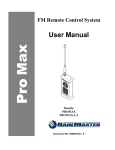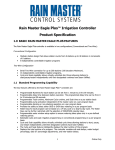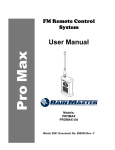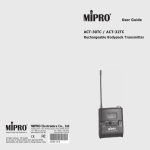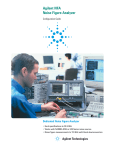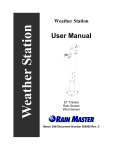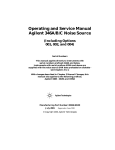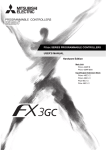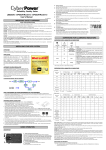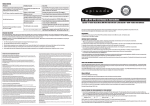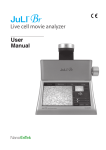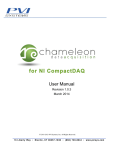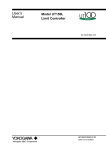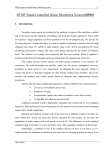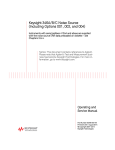Download Owner`s Manual - Rain Master Control Systems
Transcript
Rain Master Irrigation Systems RT5 User’s Manual FM Remote Control System RT5 User Manual RT5 Transmitter RR Receiver RRAD Adaptive Receiver Document No. 500012 Rev. B Rain Master Irrigation Systems RT5 User’s Manual Table of Contents 1.0 Introduction........................................................................................................2 1.1 Range and Method of Transmission................................................................................... 3 2.0 Using the Receiver with a Rain Master Controller ........................................3 2.1 2.2 2.3 2.4 2.5 2.6 2.7 2.8 Connecting the Receiver to a Rain Master Controller........................................................ 4 Disconnecting the Receiver from a Rain Master Controller .............................................. 4 Using the RRAD Adaptive Receiver with a Non Rain Master Controller......................... 5 Installing the Permanent Connector and Turning on the Receiver..................................... 5 Installing the Temporary Connector and Turning on the Receiver.................................... 8 Disconnecting the Receiver from the Non Rain Master Controller ................................... 8 If 24 VAC is not available from a Non Rain Master Controller to Power the RRAD Adaptive Receiver .............................................................................................................. 8 How to Use the RRAD Receiver for System Checkout ..................................................... 9 3.0 Using the Transmitter .......................................................................................9 3.1 3.2 3.3 3.4 3.5 3.6 Sending Commands............................................................................................................ 9 Auto Up and Auto Down Buttons .................................................................................... 10 On and Off Buttons .......................................................................................................... 10 Master Valve/Pump Button .............................................................................................. 10 Multiple Valves On .......................................................................................................... 11 Controller Access Code – CAC........................................................................................ 11 4.0 Low Battery and Recharging the Transmitter Battery ...............................12 4.1 Transmitter Battery Replacement..................................................................................... 12 5.0 Troubleshooting Electrical Problems ............................................................13 5.1 5.2 5.3 5.4 If you Suspect a Short in the Wiring or Solenoid............................................................. 13 Field Wiring Shorts, the Receiver, and the Rain Master Controllers............................... 13 Field Wiring Shorts, the Receiver, and Non Rain Master Controllers............................. 13 Note about Solenoids........................................................................................................ 13 6.0 REMOVAL AND REPLACEMENT OF ANTENNAS...............................14 7.0 WIRE CHART FOR ALL REMOTE CONTROL CONNECTORS.........14 Rain Master Limited Warranty ...........................................................................16 Page ii Rain Master Irrigation Systems RT5 User’s Manual Table of Figures Figure 1: RT5 FM Remote Control System................................................................................... 1 Table of Tables Table 1 - RT5 Parts List.................................................................................................................. 4 Table 2 – Cable Wire Table .......................................................................................................... 15 CAREFUL, CAUTION, DANGER: Information furnished by Rain Master Irrigation Systems Inc. is believed to be accurate and reliable. However, Rain Master shall not be liable for errors contained herein or for incidental or consequential damages in connection with the furnishing, performance or use of this material. The information contained in this document is subject to change without notice. Notice: Information furnished by Rain Master Irrigation Systems Inc. is believed to be accurate and reliable. However, Rain Master shall not be liable for errors contained herein or for incidental or consequential damages in connection with the furnishing, performance or use of this material. The information contained in this document is subject to change without notice. Page iii Rain Master Irrigation Systems RT5 User Manual RT5 Remote Control Congratulations… you have chosen one of the ultimate tools to use in keeping maintenance costs down and satisfaction high – the Rain Master RT5 Remote Control System. Rain Master engineer’s take great pride in all their work and see includes the RT5. You’ll find it packed with features you’ve been looking for and it’s extremely easy for everyone to use. The RT5 has been designed to give you years of dependable service. To take full advantage of all the ways RT5 can help you do your job more efficiently and economically, please take a few minutes and read your User Manual. It won’t be long before your best friend in the field is the RT5. Figure 1: RT5 FM Remote Control System Page 1 Rain Master Irrigation Systems 1.0 RT5 User’s Manual Introduction Our Patented Remote Control system was designed to eliminate that expensive wasted time and energy spent walking back and forth between the controller and the field. I t makes light work of system check outs and service work. It provides field personnel with complete control over the irrigation controller. We use a specially assigned FM frequency for transmission. FM was selected due to its inherent quality and immunity to static and electrical interference which are commonly found in AM types of equipment such as citizen’s band radio, garage door openers, etc. Additionally, we use coded signals on our FM frequency as a further measure of security. Various frequencies are available from Rain Master should the FCC or governing Telecommunications authority require it. The features described below are found only in those units manufactured after August 1989. They have three or more numerical digits to the right of the decimal point in the serial number – for reference purposes, when needed, these will be referred to as POST August 1989 units (as compared to PRE August 1989). If you have only two digits, the units do not contain the following features. Controllers may be operated remotely from watering zone sites allowing immediate evaluation of the irrigation configuration and performance. Using the hand-held battery operated RT5 Transmitter from a remote zone location; the operator may turn ON a single station or any number of stations with the push of a few simple keys. An access code feature allows independent control of multiple RT5 receivers permanently installed in up to 999 controllers. In addition to the maintenance features, the RT5 system provides specialized irrigation functions, which are described in Section 1.1. SECURITY ACCESS CODE – SAC, POST 8/89 The Security Access Code (SAC) has been added to allow multiple remote control sets to be used within five miles of each other, on the same frequency, without interference. It is of great value to the user with more than one remote who operate in close proximity to each other. It also prevents interference by any type of radio user who may be in the same frequency – improperly or not. The SAC is transparent to you – you need not concern yourself with it but you should remember that each receiver and transmitter is now a tied together pair. CONTROLLER ACCESS CODE – CAC, POST 8/89 This allows the user to have numerous receivers permanently attached to controllers (any Manufacturer’) at different geographic sites each with their own Controller Access Code (CAC). One transmitter can be used to address them individually. It must be set by the factory – if requested at the time the unit is ordered, there is no charge. Page 2 Rain Master Irrigation Systems RT5 User’s Manual MULTIPLE VALVES ON, POST 8/89 Under normal conditions, in the adaptive mode, the receiver will not allow more than one valve plus the master valve to be on at a time – it makes troubleshooting easier. However, the remote set can be configured to allow multiple valves to be turned on (for valve-in-head system), but this must be set by the factory – if requested at the time the unit is ordered, there is no charge. WHEN PRESSING ANY BUTTON, POST 8/89 Press a key and the remove your finger, you need not keep your finger on the button. Wait for approximately 1/3 of a second, for the tone to end, before pressing another button. The RT5 remote control system is composed of the following equipment: 1.1 Model No. Description RT5 FM Remote Transmitter for one mile non-line-of-site. RR FM Rain Master Receiver for rain Master controllers only. RRAD FM Rain Master Receiver Adaptive for Rain Master and other manufacturers’ 24-volt AC controller. (See Section 3.0) Range and Method of Transmission It is impossible to predict exactly the distance over which the units will transmit and receive. Atmospheric disturbances, buildings, hills, etc., all affect radio waves. Whether or not the battery is fully charged also affects how far the unit will transmit. However, our units are designed to cover distance of one mile with a fully charged battery. In open field conditions they will cover a distance of three to seven miles. The receiver/transmitter pair uses a coded method of FM transmission which assures you of interference-free operation. Additionally, due to its advanced design, our transmitter only draws significant power when a button is pressed; there is no need to continually turn the unit off unless it is not going to be used for fifteen minutes or more. 2.0 Using the Receiver with a Rain Master Controller One of the unique and patented features of Rain Master Controllers is the built-in capability for remote control. Making the connections between the hands held remote transmitter and the RT5 receiver, which is attached to the controller, takes just a few seconds. The RT5 receiver is designed to connect directly to any Rain Master controller by plugging the 9-pin connector from the RT5 receiver into the front panel remote control jack found on all Rain Master controllers. Page 3 Rain Master Irrigation Systems RT5 User’s Manual Table 1 - RT5 Parts List Part No. PM-XMTR PM-RCVR PM-SER99 500055 PM-CASE PM-ANT-XMTR PM-ANT-RCVR 2.1 Ref. 1 2 3 4 5 6 7 Description RT5 Remote radio transmitter RT5 Remote receiver 36” remote cable RT5 User’s manual RT5 carrying case Antenna, BNC Antenna, hinged, BNC Connecting the Receiver to a Rain Master Controller Connecting the receiver to the controller is very simple, however, please follow the procedure, to do otherwise will cause damage to the units. 1. Make sure the controller is in the Automatic Mode, if it is not, press the controller’s QUIT key. 2. Make sure the controller’s RAIN SWITCH is in the AUTO position. 3. Stand the receiver on top of the controller with the antenna straight up. Do not allow the antenna to touch any metal objects or wire. 4. Turn the receiver OFF. If this is not done, damage may occur when it is plugged in. 5. Align the receiver’s plug to the remote control jack on the front panel of the controller (it will only fit in one position) and then plug it in. The controller’s display will go blank. If it does not, unplug it and begin Step 5 again. NOTE: POST 8/89 units will not make the display go blank. 6. Turn the receiver’s ON. NOTE: POST 8/89 units will now make the display go blank. 7. It is now ready to receive commands from the transmitter. 2.2 Disconnecting the Receiver from a Rain Master Controller To disconnect the receiver, follow the procedure below. 1. Turn the receiver OFF. If this is not done, damage may occur when it is unplugged. NOTE: POST 8/89 units the controller will turn all stations off and it will return to the Automatic Mode. Page 4 Rain Master Irrigation Systems RT5 User’s Manual 2. Disconnect the receiver’s plug from the controller’s front panel by grasping the plug’s body, not the cable, and pulling straight out. When the PRE 8/89 receiver is disconnected, the controller will turn all stations off and it will go back to the Automatic Mode. 2.3 Using the RRAD Adaptive Receiver with a Non Rain Master Controller Basically the controller serves only two purposes when using the adaptive receiver. First, it provides 24 VAC for the receiver. Never allow more than the “normal” 24 VAC (up to 28 VAC is OK) to enter the receiver through the wires designated for the 24 VAC. If the controller runs on a voltage other than 24 VAC, use a transformer to convert the voltage down to the 24 VAC for the input into the receiver. Transfomers which convert higher voltages to 24 VAC are available from Rain Master. Secondly, the controller serves as a point of connection for the field wires and the receiver’s output. Usually the point of connection is the terminal strip or quick disconnect within the controller or pedestal. Rain Master offers several types of connectors for wiring to the controller. A 32PC or 24PC Permanent Connector which is meant to be left with the controller. The other is the 32TC Temporary Connector using alligator clips. 2.4 Installing the Permanent Connector and Turning on the Receiver To install a PC Permanent Connector, follow the instructions below. 1. Remove power fro the controller. 2. Connect each wire for stations 1 through 24 or 32 of the 24PC or 32PC to the controller’s terminal strip. Note that the field wiring should remain connected and in place. Simply add the PC wiring to it. Make sure to follow the station color code list at the end of this manual. Also make sure that any unused station wires on the PC are sealed off and cannot short to any metal object. If there is a master valve/pump in the system, make sure you understand how the clock controls it before hooking up the Master Valve/Pump wire to the PC cable. If Page 5 Rain Master Irrigation Systems RT5 User’s Manual there is any doubt – find out before connecting it – voltages above the “normal” 24 VAC will damge the unit. IF THE CLOCK SIMPLY PUTS OUT 24 VAC TO ACTIVATE THE MVP then simply connect the MVP wire to the PC cable to the controller’s MVP trtminal. IF THE CLOCK ACTS AS A SWITCH TO ACTIVATE THE MVP (finding two terminals in the controller associated with the MVP usually but not always inducate this) then a relay will be required. The relay is wired such that its coil terminals are activated by the MVP and COM of the PC cable and its switch contacts are in parallel with the clock’s two terminals. See figure below. MVP wire >----------- | |-------------Æ To PC | | | | COIL COM of PC SWITCH To MVP switch | | type terminals of | | Clock | | Or clock >------------- | |-------------Æ RELAY such as Rain Master RLY1 3. Connect the wires for the PC common to the COM terminals of the controller. 4. Important – if the 24 VAC is not available from the controller’s terminal strip, see Section 2.7 and skip to Step 6 below. Page 6 Rain Master Irrigation Systems RT5 User’s Manual 5. Connect the wire for the PC’s 24 VAC to the 24 VAC terminal of the controller. Note that the PC has only one wire for the 24 VAC despite the controller having two 24 VAC terminals. This is because the controller takes one of its 24 VAC terminals and connects it to the COM terminal and you have already attached the PC’s COM wire to the controller’s COM. Because of this you must find which 24 VAC terminal on the controller is NOT electrically the same as the controller’s COM terminal and connect the PC’s 24 VAC wire to it. This can be done using a voltmeter. Power up the controller and set the voltmeter on a 50 VAC sacle or higher. Place one of the voltmeter leads on the controller’s COM and try the other lead of the meter on each of the 24 VAC terminals. Connect the PC’s 24 VAC wire to whichever terminal gives a reading of 24 VAC on the meter. If the controller does not have any terminals marked 24 VAC then leave one of the voltmeter leads on the controller’s COM and try the other lead of the meter on the low voltage wires on the secondary of the controller’s transformer. Connect the PC’s 24 VAC wire to whichever terminal gives a reading of 24 VAC on the meter. 6. Place the RAIN SWITCH in the OFF of RAIN position. 7. Turn the receiver off. If this is not done, damage may occur when it is plugged in. 8. Align the connector of the PC with the connector on the receiver and plug them together. 9. Turn the receiver on. It is now ready to receive commands from the transmitter. Page 7 Rain Master Irrigation Systems 2.5 RT5 User’s Manual Installing the Temporary Connector and Turning on the Receiver The TC Temporary Connector is wired in the exact same fashion as the permanent Connector described above except that it uses alligator clips for the connection to the terminal strip within the controller so that it may be easily attached and removed. Follow the connection instructions for the Permanent Connector but be very careful that the alligator clips are secure and not “shorting” to any metal, etc. 2.6 Disconnecting the Receiver from the Non Rain Master Controller To disconnect the receiver, follow the procedure below. 1. 2. Turn the receiver OFF. If this is not done damge may occur when it is unplugged. Disconnect the reciver’s plug from the PC or TC cable by grasping the plug’s body, not the cable, and pulling straight out. 2.7 If 24 VAC is not available from a Non Rain Master Controller to Power the RRAD Adaptive Receiver If 24 VAC is not available from the controller, use a transformer to convert from the line voltage (probably 117 or 120 VAC) to 24 VAC and run the 24 VAC into the PC on the two wires designated for 24 VAC and COM. There is no need to worry about the polarity of these two connections. Additionally, connect the PC’s COM wire to the controller’s COM terminal. DO NOT connect the PC’s 24 VAC wire to the controller. ************************************* * * * Non-Rain Master Controller * * without 24 VAC * * * * COM * ************************************* | | ******************* | >---------------- * *-------------------Æ COM on PC High-Voltage * Transformer * 24 VAC output Input * >--------------- * * of transformer *-----------------Æ 24 VAC on PC ******************* Page 8 Rain Master Irrigation Systems 2.8 RT5 User’s Manual How to Use the RRAD Receiver for System Checkout It is possible to check out an irrigation system that does not have a controller in place simply by using a small generator and a transformer – usually the plu-in type such as Rain Master Part No. TR4. Simply connect the PC or TC wires up to the field wires for the stations. Connect the PC/TC’s COM and 24 VAC wires to the transformer as shown in Section 2.7 but without the controller. IMPORTANT – make sure the RRAD receiver is turned off AND get the generator up to speed before plugging the transformer into the generator. Plug the RRAD into the PC/TC connector and turn it on. 3.0 Using the Transmitter CAUTION: There are two precautions that must be observed. 1. There is more to an antenna than just a piece of wire. Do not use an antenna that is bent or broken. Damage may occur and performance will be minimal at best. 2. Do not press a button to transmit unless the transmitter’s antenna is connected. Damage may occur and strength of the signal will be minimal. Because of the advanced design of the transmitter, once you turn the unit on and begin your work, there is no need to turn it off just because it is going to be a few minutes before you press another button. Turning the unit off will not hurt but you need not do so because of concern for the battery. Note that turning the transmitter off in the middle of your work will not change the status of the irrigation system. For example, if you have turned on Station 3 and then turn the transmitter OFF, station 3 will stay on until you again turn the transmitter on and send some new command (or unplug the receiver). 3.1 Sending Commands When one of the transmitter’s buttons is pressed a signal is transmitted. Pressing the button for ¼ second is all that is required. Pressing longer will not hurt, but it does nothing. When a button is pressed, an audible tone is generated simply to tell you that the signal has been sent. All stations, except the MV/P, are turned on by pressing the number of the station and then pressing the ON button. To turn off a station simply press OFF. To turn the station on again, press ON. There is no need to again press the station’s number until a new station is desired. Page 9 Rain Master Irrigation Systems RT5 User’s Manual Note that the controller will only allow you to have one station on at a time (except the Master Valve/Pump) so when you send a command to turn a station on, any station turned on previously will be automatically turned off. EXAMPLE: You wish to turn Station 12 on, off and then on again. Press: 1, 2 ON OFF ON Station 12 is now on, if you wish to go to station 3, there is no need to turn 12 off simply press: 3 ON The controller automatically turned Station 12 off prior to turning Station 3 on. 3.2 Auto Up and Auto Down Buttons For convenience and rapid checkout of a system, pressing AUTO UP will turn off the current station and turn on the next. There is no need to enter the station number. Similarly, pressing AUTO DOWN will turn off the current station and turn on the station of the next lower number. Once you find the station you want, you may turn it on and off simply by pressing the ON and OFF buttons. There is no need to know the station number. EXAMPLE: You come to a job site and you know it has a problem but you don’t which station has the problem. Simply hook up the receiver, go out to the field and press the AUTO UP until you find the problem. Then use the ON and OFF buttons. 3.3 On and Off Buttons Pressing the ON button will turn on whatever station you are currently working with as was shown above. Pressing the OFF button will turn off whatever station you are currently working with as was shown above. 3.4 Master Valve/Pump Button The Master Valve/Pump may be turned on/off anytime. Its condition is not affected as other valves are commanded on/off. Therefore, checkout of an electrical problem on any valve may be accomphlished without actually watering simply by commanding the MV/P off. Page 10 Rain Master Irrigation Systems RT5 User’s Manual This assumes the system has a Master valve/Pump. EXAMPLE: MV/P ON To turn the Master Valve/Pump on, press: To turn it off, press: MV/P OFF 3.5 Multiple Valves On Under normal conditions, in the adaptive mode, the receiver will not allow more than one valve plus master valve on at a time. However, the remote set can be configured to allow multiple valves on (but this must be set by the factory – if requested at the time the unit is ordered, there is no charge). If this feature is active, the unit functions in all aspects as explained in this manual except that if a valve is already on and another valve is commanded on, the previous valve will not go off – it must be commanded off by using its number. EXAMPLE: Press: 7, ON Valve 7 is now on. 3, ON valves 7 and 3 are now on. 9, ON valves 7, 3, and 9 are now on. 7, OFF turns 7 off leaving 3 and 9 on OFF would turn off 9 leaving 3 on OFF would turn off 3 3.6 Controller Access Code – CAC In essence the Controller Access Code is used to enable/disable the receiver. This allows the user to have numerous receivers permanently attached to controllers (any manufacturer’) at different geographic sites each with their own Controller Access Code. One transmitter can be used to address them individually. It works in the following fashion (but must be set by the factory – if requested at the time the unit is ordered, there is no charge): You must know the Controller Access Code of the individual receivers. It can be found on the label on the back of the receiver. EXAMPLE: to enable receiver #1, press: CAC, 1, ON Receiver number 1 is now enabled and it will respond to all commands from the transmitter. Page 11 Rain Master Irrigation Systems RT5 User’s Manual EXAMPLE: To disable receiver number 1, press: CAC, 1, OFF Receiver number 1 is now disabled and will not respond to any commands. Controller Access Code Note 1: If the Controller Access Code is being used and the receiver is plugged into the Remote Jack on the front panel of a Rain Master controller, the controller will go in and out of the Automatic Mode as you use the Controller Access Code to enable/disable the controller. Controller Access Code Note 2: It is also possible to disable any and all enabled receiver(s) without using their Controller Access Codes by pressing: CAC, OFF Controller Access Code Note 3: It is possible to have more than one receiver enabled simultaneously, but all enabled receivers would, therefore, respond to commands from the transmitter. 4.0 Low Battery and Recharging the Transmitter Battery The Transmitter has a LOW BAT light to indicate when the batteries are low and need to be recharged. First indication of a low battery will most often occur when a button is pressed to transmit a signal because this is when the power is required. To charge the batteries follow the procedure below. 1. Plug the charger into a standard 120 VAC, 50/60 Hz wall receptacle and charge for at least 14 hours. DO NOT CHARGE FOR MORE THAN 24 HOURS. Make sure the receptacle is not controlled by a light switch. 2. Turn the transmitter off and plug the cable from the wall-plug-in charger into the transmitter’s BATT CHARGER jack. THE TRANSMITTER MUST BE OFF TO CHARGE. Note that charging for more than 24 hours will not increase the capacity of the battery and it is recommended that the unit not be left charging for more than four (4) days. 4.1 Transmitter Battery Replacement Due to the variable use a battery receives, it is impossible to predict exactly how long the battery will last. In general, you may expect a lifetime of two to five years. Should replacement become necessary, the transmitter must be returned to the Rain Master or to a Rain Master Authorized Repair Center. Page 12 Rain Master Irrigation Systems 5.0 RT5 User’s Manual Troubleshooting Electrical Problems 5.1 If you Suspect a Short in the Wiring or Solenoid If you suspect there is a short in either the wiring of the solenoid on a station and then it is important to understand will occur when you transmit a signal to the controller to turn on that station. 5.2 Field Wiring Shorts, the Receiver, and the Rain Master Controllers This is best illustrated by example. If there is a short on Station 3 and you attempt to send a command to turn on station 3 (3, ON), the controller will turn Station 3 on, but the controller’s circuit breaker will open and the controller will shut down. The circuit breaker on top of the RRAD receiver will not be affected and is not used when working the rain Master controllers. At this point you must go back to the controller, disconnect the receiver (as described in paragraph 2.2 or 2.6), reset the controller’s circuit breaker and reconnect the receiver (as described in paragraph 2.2 or 2.3). Remember, that if the short is not fixed, this same problem will occur whenever Station 3 is turned on. 5.3 Field Wiring Shorts, the Receiver, and Non Rain Master Controllers This is best illustrated by example. If there is a short on Station 3 and you send a command to turn it on (3, ON), the controller will turn Station 3 on and either the controller’s circuit breaker will trip or the circuit breaker on top of the RRAD receiver will trip or both. You must go to the controller, disconnect the receiver (as was explained above), reset the circuit breaker as well as the controller’s circuit breaker and reconnect the receiver (as was explained above). Remember, that if the short is not fixed, this same problem will occur whenever Station 3 is turned on. 5.4 Note about Solenoids This has little to do with using a remote control, but it is important information to know. A solenoid should never be turned on without a plunger in it. If this is done, the solenoid may draw 2 to 5 times it normal current. This causes rapid and dangerous heating and can destroy the solenoid very quickly. Depending upon the solenoid, the current draw may be enough to trip the controller’s circuit breaker. Page 13 Rain Master Irrigation Systems 6.0 RT5 User’s Manual REMOVAL AND REPLACEMENT OF ANTENNAS Antennas are not just a piece of wire. If an antenna on either the receiver or the transmitter becomes damaged, severely bent or broken, replace it only with an exact replacement from your authorized distributor or contact Rain Master Irrigation Systems. The antenna on either unit may be removed and replaced by you. To remove the antenna, simply turn the unit off and gasp the antenna at its base, press down lightly and turn ¼ turn counter clockwise until it stops. Then gently pull the antenna up. Do not attempt to use the transmitter without an antenna. To replace the antenna, make sure the unit is off, align the antenna with the connector, push down lightly and turn ¼ turn clockwise until it locks into position. 7.0 WIRE CHART FOR ALL REMOTE CONTROL CONNECTORS 32PC PERMANENT CONNECTOR 32EX EXTENSION CONNECTOR 32TC TEMPORARY CONNECTOR 24PC PERMANENT CONNECTOR 24EX EXTENSION CONNECTOR 24TC TEMPORARY CONNECTOR Please refer to the instruction manual of the remote control for the proper procedure to connect the enclosed harness. NOTE: DO NOT USE A 24 STATION RRAD RECEIVER WITH AA 32PC OR 32TC UNLESS YOU DICONNECT AND INDIVIDUALLY INSULATE THE WIRES AND STATIONS 25 – 32 INCLUSIVE. This User Manual serves as a chart between the stations and the wire color codes. USE OF ANY NON-RAIN MASTER CONNECTOR WITH OUR REMOTE CONTROL WILL VOID THE WARRANTY. Page 14 Rain Master Irrigation Systems RT5 User’s Manual Table 2 – Cable Wire Table STATION 1 2 3 4 5 6 BASE COLOR BLACK WHITE RED GREEN ORANGE BLUE 1ST STRIPE 7 8 9 10 11 12 WHITE RED GREEN ORANGE BLUE BLACK BLACK BLACK BLACK BLACK BLACK WHITE LARGE LARGE LARGE LARGE LARGE LARGE 13 14 15 16 17 18 BLUE RED ORANGE BLACK WHITE RED RED GREEN GREEN WHITE BLACK BLACK RED RED WHITE LARGE LARGE LARGE LARGE LARGE LARGE 19 20 21 22 23 24 GREEN ORANGE BLUE BLACK WHITE RED BLACK BLACK BLACK RED RED BLACK WHITE WHITE WHITE GREEN GREEN GREEN LARGE LARGE LARGE LARGE LARGE LARGE 25 26 27 28 29 30 31 32 BLACK WHITE RED GREEN BROWN BLUE ORANGE YELLOW MV/P GREEN COM 24 VAC RED OR ORANGE BLUE 2ND STRIPE CABLE SIZE LARGE LARGE LARGE LARGE LARGE LARGE SMALL SMALL SMALL SMALL SMALL SMALL SMALL SMALL WHITE LARGE WHITE RED LARGE WHITE LARGE Page 15 Rain Master Irrigation Systems RT5 User’s Manual Rain Master Limited Warranty Rain Master Irrigation Systems Inc. warrants to the first customer purchaser that this Rain Master brand product (the “product”), when shipped in its original container, will be free from defective workmanship, and materials and agrees that it will, at its option, either repair the defect or replace the defective product or part thereof at no charge to the purchaser for parts or labor for the time period set forth below. This warranty does not apply to any appearance items of the product nor to any product has the exterior of which been altered or modified in design or construction. (See additional exclusion below). This limited warranty described above is in addition to whatever implied warranties may be granted to purchasers by law. This limited warranty does not apply to product failure caused by improper installation or grounding, improper handling, physical abuse, neglect, whether accidental or malicious, acts of God, such as lightning and/or power surges, floods, earthquakes, hurricane, tornados, vandalism etc. (All implied warranties including the warranty of merchantability, and fit for use are limited to the period(s) from date of purchase set forth below). Neither the sales personnel of the seller nor any other person is authorized to make any warranties other than those described above, or to extend the duration of any warranties beyond the time period described herein. The warranties described above shall be the sole and exclusive warranties granted by Rain Master Irrigation Systems Inc. and shall be the sole and exclusive remedy available to the purchaser. Correction of defects, in the manner and period of time described herein, shall constitute complete fulfillment of all liabilities and responsibilities of Rain Master to the purchaser with respect to the product, and shall constitute full satisfaction of all claims, whether based on contract, negligence, strict liability or otherwise. In no event shall Rain Master be liable or in any way responsible, for any damages or defects in the product which were caused by repairs or attempted repairs performed by anyone other than a Rain Master Service dealer or center. Nor shall Rain Master be liable or in any way responsible for an incidental or consequential economic or property damage. Some states do not allow the exclusion of incidental or consequential damages, so the above exclusion may not apply to you. The Rain Master RT5 series products carry a 2 year limited warranty unless otherwise specified. In order to enforce the rights of this limited warranty, please follow the directions as described in the following sections. SERVICE Prior to sending your RT5 system for service: 1. Please refer to the troubleshooting section of the manual for possible solutions. 2. Contact Rain Master Technical Support at (805) 527-4498. Be sure you can describe your problem(s) and if possible, be able to reproduce your problem(s) while ON the phone. You will need the serial numbers of both your RT5 transmitter and RT5 receiver. 3. If required to ship, ensure the unit is properly packaged, preferably in the original shipping case. Include all cables and components, and make sure adequate packaging material is used to protect the unit(s) from shipping abuse. 4. Enclose a complete description of the type of problem that is occurring, and be sure to include your name, address and phone number where you can be reached. 5. Product can be: A. Sent or take to an authorized Rain Master Distributor. Call Rain Master at (805) 5274498 for nearest distributor. Page 16 Rain Master Irrigation Systems B. RT5 User’s Manual Sent or take to: Rain Master Irrigation Systems Attn: Service Dept. 310-B Royal Ave. Simi Valley, CA 93063 3910-B Royal Avenue Simi Valley, California 93063 Telephone: (805) 527-4498 Fax: (805) 527-2813 www.Rainmaster.com Page 17




















